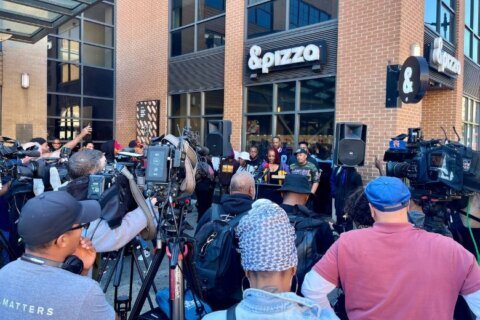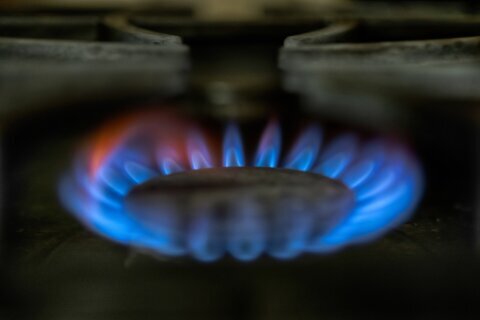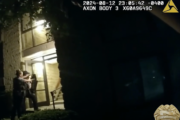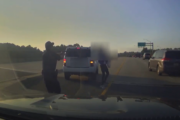Sizzling-hot temperatures have broken records (again), and many in the D.C. area are seeking any way to keep cool and safe during this hazardous heat. Here’s what you need to know.
Even without the heat index, temperature records at all three major D.C.-area airports were broken today, all recording 99 degrees.
Kevin Witt at the National Weather Service told WTOP that “the record at Reagan for today was 97 degrees. That was set back in 1881. We broke that reaching 99 degrees. And then Baltimore Washington International Airport … in 1954, it was 96. And we broke that at 99 as well. And then for Dulles International Airport. We had a record of 96 degrees back in 1985. And we broke that with 99 degrees.”
Record-high temperatures are expected to last through the next couple of days, and the National Weather Service even issued a heat advisory for the D.C. region that ran through Tuesday afternoon until 8 p.m.
Overall, the NWS has labeled the beginning of our week as a Hazardous Weather Outlook, which means extra measures should be taken to shelter, stay cool and hydrated, and check up on those more vulnerable to the heat.
With the humidity, the heat index is expected to range from 100 to 105 degrees.
By 4 p.m. Tuesday, Dulles International Airport hit temperatures of 97, according to 7News meteorologists. The previous record there, 95, was set in 1985, according to the National Weather Service.
Steve Rudin, a 7News First Alert meteorologist, said evening temperatures won’t dip below 80 degrees until the early morning hours.
- Listen to WTOP online and on the radio at 103.5 FM or 107.7 FM.
- Current traffic conditions
- Weather forecast
- Closings and Delays
- Sign up for WTOP alerts
“The DMV is currently experiencing a sizzling September heat wave that shows no signs of letting up until the end of the week,” said 7News First Alert Meteorologist Brian van de Graaff.
Temperatures this time of year are typically in the 80s, he added.
On Monday, Reagan National Airport recorded 98 degrees while BWI Marshall Airport and Dulles International Airport hit temperatures of 99. The old record for Reagan National was 96 degrees and was set in 2019. The former record at Dulles was 95 degrees and set in 1985, 7News First Alert Meteorologist Mark Peña said.
The records for Reagan National and BWI Marshall go back more than 100 years to 1872. For Dulles, they go back since the 1960s.
Any relief for the weekend?
According to Kevin Witt with the NWS, we may see some much needed rain soon to bring some cooling our way.
“There’s some thunderstorm activity starting Thursday into the weekend, which could bring us some relief. Without that rainfall … everything calls for high temperatures and near record heat.”
However, with the rain comes some risks for severe weather, including flooding.
“That’s going to trigger off some strong to severe storms. Maybe a couple of storms that produce damaging winds if we get the right setup, maybe even some large hail, but it’s too early to tell,” Witt said. “We can’t even roll out some isolated flooding too, because the ground is hard. … So we could see some quick runoff and flash flooding isn’t out of the question either.”
Transportation issues
The heat has already sparked some transportation-related issues.
VRE, which operates commuter rail in Virginia, made changes to rush-hour trains Tuesday because the extreme heat forced some speed-related restrictions.
You can see specific commuter alerts on the VRE website.
Staying healthy in high heat
With the extended period of heat, those moving around outdoors are at heightened risk for dehydration, heat cramps, heat exhaustion, heat stroke and a number of other heat-related conditions.
Knowing the signs of heat exposure can prevent a life-threatening situation. Should any of the following occur, get out of the heat, loosen any tight or heavy clothing and drink plenty of water:
- Heat cramps: symptoms include painful muscle spasms, usually involving the abdominal muscles or legs
- Heat exhaustion: first signs are cool, moist, pale or flushed skin, dizziness, nausea, headache and weakness
- Heat stroke: the most serious sign of overexposure. Symptoms include red, hot, dry skin, weak pulse, rapid breathing and changes in consciousness. Seek medical attention by calling 911.
If you are traveling, be sure to plan your day to include times and places to cool down and rehydrate. This is especially important for drivers with children or furry friends along for the ride.
Resources around the region
In the District, the Hot Weather Emergency goes through Thursday. During a Hot Weather Emergency, the District sets up cooling centers for residents needing to seek relief from the heat.
You can find an interactive map of D.C.’s cooling centers online.
Another way to combat the heat in D.C. is by visiting any number of spray parks, which are open until Sept. 21. More information and an interactive map can be found here.
Resources and safety tips from the county can be found here.
Find more resources to prepare for and mitigate the heat at Ready.gov.
Forecast
A cold front will approach the region Thursday and will bring showers and a few thunderstorms, van de Graaff said.
“Cooler weather is in sight with highs in the 80s by the weekend and highs in the 70s next week,” van de Graaff said.
TUESDAY NIGHT: Very warm and muggy. Lows: 70s to near 80. Winds: North 5-10 mph.
WEDNESDAY: HEAT ALERT: Scattered clouds. Highs: 94-99. Heat Index: 100-105. Winds: North 5-10 mph.
THURSDAY: HEAT ALERT: Partly cloudy, PM showers and storms possible. Highs: 90s. Winds: Southwest 5-10 mph.
Current weather
WTOP’s Abigail Constantino and Jessica Kronzer contributed to this report.








